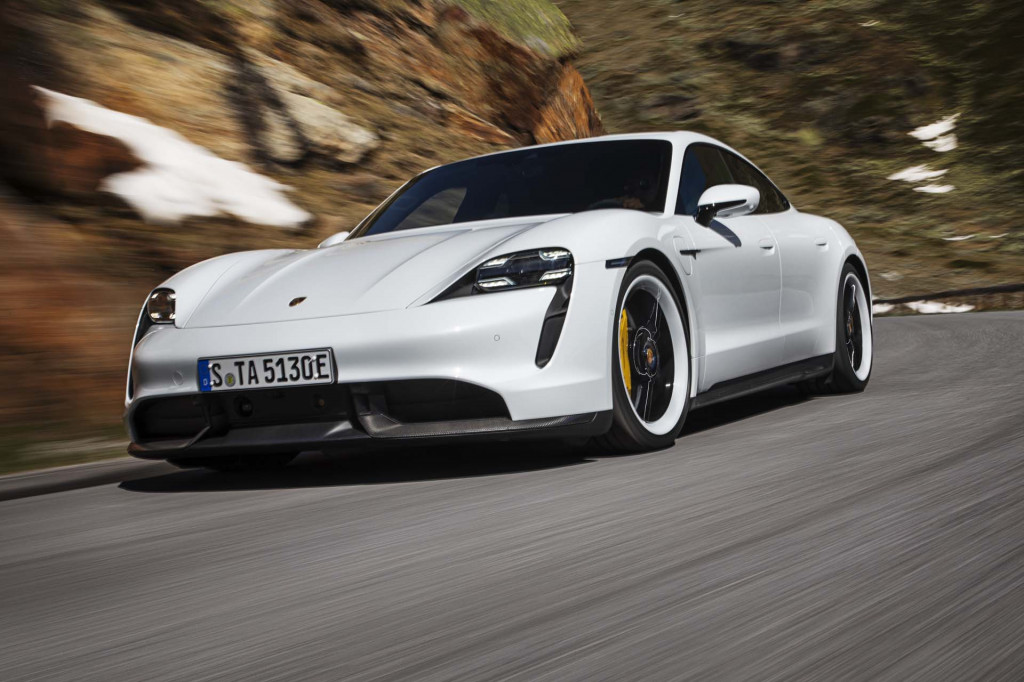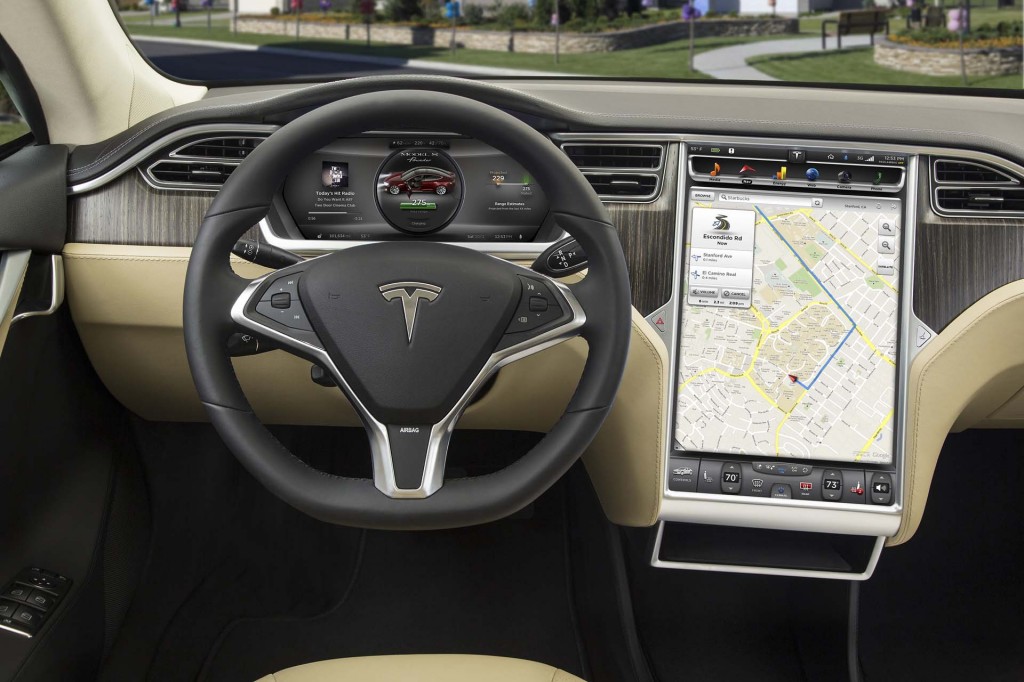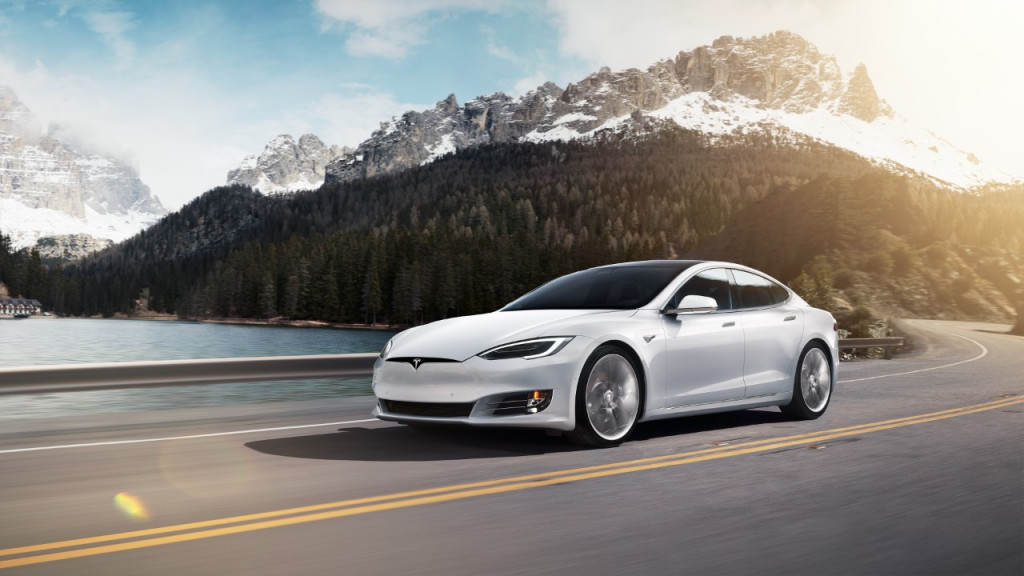The Tesla Model S was the first long-range premium electric car, and it’s been on the market for seven years. And yet just now, for the 2020 model year, arrives what some might see as its first formidable fully electric rival from Germany: the Porsche Taycan.
Although when Porsche first showed its Mission E Concept, at the 2015 Frankfurt auto show, it was broadly seen as a strike against the Model S, the Taycan has become a different car on its way to production. What was a simple, more two-dimensional idea at Porsche—catch that fast electric luxury car from California—became something uniquely Porsche in the process, borrowing heritage from the 911, building on its performance benchmarks, and becoming the debut vehicle for a new interior interface at Porsche.
While we just don’t see the 2020 Porsche Taycan as a direct rival to the Tesla Model S, it’s worth comparing these two because, after all, we’re sure that Porsche kept tabs on the Model S every step of the way, and that Tesla knew a potential threat was coming.
Range and power
Driving range is a key difference between these two electric cars. The Long Range Model S will go 370 EPA-rated miles on a charge—and to 60 mph in 3.7 seconds and to a 155-mph top speed. The Model S Performance cuts the 0-60 time to 2.4 seconds and raises top speed to 163 mph but cuts range to 345 miles. Although the Taycan hasn’t yet been rated for EPA range, Porsche has tipped that its European WLTP-cycle range is about 280 miles—which pegs the EPA number at somewhat less than that.
The Taycan’s battery is officially rated at 93.4 kwh, while Model S Long Range battery capacity is approximately 100 kwh.
Both vehicles provide DC fast charging at rates that are faster than typical among today’s electric vehicles. For now the Taycan’s the clear winner—if, that is, you can find a charger capable of going full-speed. Under Tesla’s Supercharger V3 hardware the Model S can charge at up to 210 kw to regain about 170 miles of range in 30 minutes. At specially equipped CCS fast chargers capable of delivering 800V, the Taycan can charge at up to 270 kw to get from 5 to 80 percent state of charge in just 22.5 minutes.

2020 Porsche Taycan

2019 Tesla Model S
The Tesla Model S Performance, equipped with Ludicrous mode, has been schooling people in “fast” cars at drag strips and stoplights for years. But the Model S isn’t always consistent with its straight-line acceleration runs (you need to pre-condition the battery for the strongest acceleration), and it’s not quite a sport sedan in the classic ride-and-handling sense. Think of it as a comfortable-riding big four-door that accelerates very quick.
The Taycan Turbo has 616 horsepower, or 670 hp with Launch Control, and 626 pound-feet of torque. Turbo S models go to 750 hp with Launch Control instead—and 774 lb-ft of torque. The Tesla Model S Performance produces 762 hp and 723 lb-ft of torque, and its power and motor systems were part of an extensive update to the Model S and X earlier this year. The Taycan is slightly heavier, but really it’s nearly a tossup on power/torque to weight.
If you like stout German engineering, performance consistency, and complex and clever steering and chassis systems, the Taycan is your car. Its 0-60 mph acceleration is officially 2.6 seconds in Turbo form, with its top speed a slightly lower 161 mph. But with a two-speed rear gearbox and meticulous power controls and battery cooling Porsche claims that it can deliver the same numbers for ten or more times in a row. Porsche’s also counting on the Taycan’s handling and brakes to be the edge—with air suspension, anti-roll, and rear-steer systems (plus a suite of driving modes) that are borrowed from the brand’s other performance cars.
The two cars have a very different philosophy with respect to regenerative braking. Lift up off the accelerator in the Tesla Model S and it scrubs off speed rather quickly, tasking the motors as generators, and saving the brake pedal for the friction brakes. In the Taycan, lifting off the accelerator sets you up to coast or glide, if there’s no traffic ahead, while the brake pedal manages regenerative braking and traditional brakes.
Interior and exterior
A quick glance at the design, the interior, and the interface make abundantly clear that the Taycan appeals to people who have and like Porsches, and want an electric one—much less to try to mimic Tesla’s interface or way of doing things.
First things first: The Model S is a hatchback that looks like it’s a sedan from the outside. The Taycan is a sedan that looks like it might be a hatchback from the outside.

2017 Tesla Model S

2020 Porsche Taycan
The huge tablet-style interface of the Tesla Model S was groundbreaking back in 2012, and while its 17-inch vertical display size hasn’t changed over the years its clarity and processor speed have improved. The Model S still has plenty of traditional switchgear but most controls are focused on the touchscreen.
The Taycan takes a completely different approach, either versus the Model S or versus Porsche’s other current production models. With up to five screens inside but few hard buttons, it allows a flexible screen space so that the driver can configure things to please—including minimalist settings that turn most of it off except for a gauges right in the line of sight. The center-console screen has haptic feedback and writing recognition and well, there are simply a lot of options.
Over-the-air updates will be supported by the Taycan on a broader level beyond infotainment functions eventually, but don't ever expect to see the sudden after-the-reboot changes you might get to braking in a Tesla, for instance.
Overhead in the Model S there’s a glass roof, although it contains more framing that protrudes downward—something Porsche was careful to engineer out with the Taycan, creating a long, bright panoramic glass roof that's framed as part of the body structure.
Interior appointments in the Model S, though they’ve improved over the years, remain a low point, as they just don’t feel on par to those in modern luxury sedans. The Taycan’s interior has the seemingly endless array of possibilities for customization and materials that’s typical for Porsche, and you can even get a fully vegan interior, something that’s still not offered (not quite) on the Model S.
The Model S is surprisingly spacious in back for adults. We haven’t been in the back of the Taycan, but it looks a little more cramped. The seven-seat version of the Model S, which added two rear-facing jump seats, is no longer available.
In the Model S there’s a huge frunk that’s large enough for a respectably sized carry-on suitcase, or a couple of backpacks. There’s one in the Taycan, too, just smaller.
Both electric cars are surprisingly quiet at highway speeds, with good damping-out of wind and road noise. Though Tesla aims to keep out motor and powertrain noise, the Taycan includes some motor sounds—especially when you opt for the Porsche Electric Sport Sound, which uses sound-system speakers to supplement a stepped-down version of its motor sound.

2019 Tesla Model S

2020 Porsche Taycan live shots
Price, sales, and the ecosystem
For most luxury-car shoppers, who are still shopping to a budget, the two vehicles are in a different league from each other in price. Tesla made huge price cuts on the Model S (along with the Model X) earlier in 2019. The Model S now starts at $81,100 and ranges up to $101.100 for the Model S Performance (with Ludicrous)—and you can add about $15,000 through premium interior trims, upgraded wheels, and the ($6,000) Full Self-Driving Capability option.
The Taycan Turbo will start at $152,250 while the Turbo S starts at $186,350 (not counting premiums at launch). Although full details on options and pricing aren’t yet available, It isn’t uncommon to see options adding up to $20,000 or more on a Porsche vehicle.
The choice between these cars is a polarizing one, and it becomes more exaggerated when you consider the whole ownership experience. Cars aside, you're likely either won over by the simplicity and tech-elegance of the Tesla ecosystem—and its way of buying, servicing, updating, and supporting vehicles and owners—or you're not. If you like the boutique approach of a dealership you have a relationship with at your beck and call, a car you manage and update like a smartphone might not be for you.













